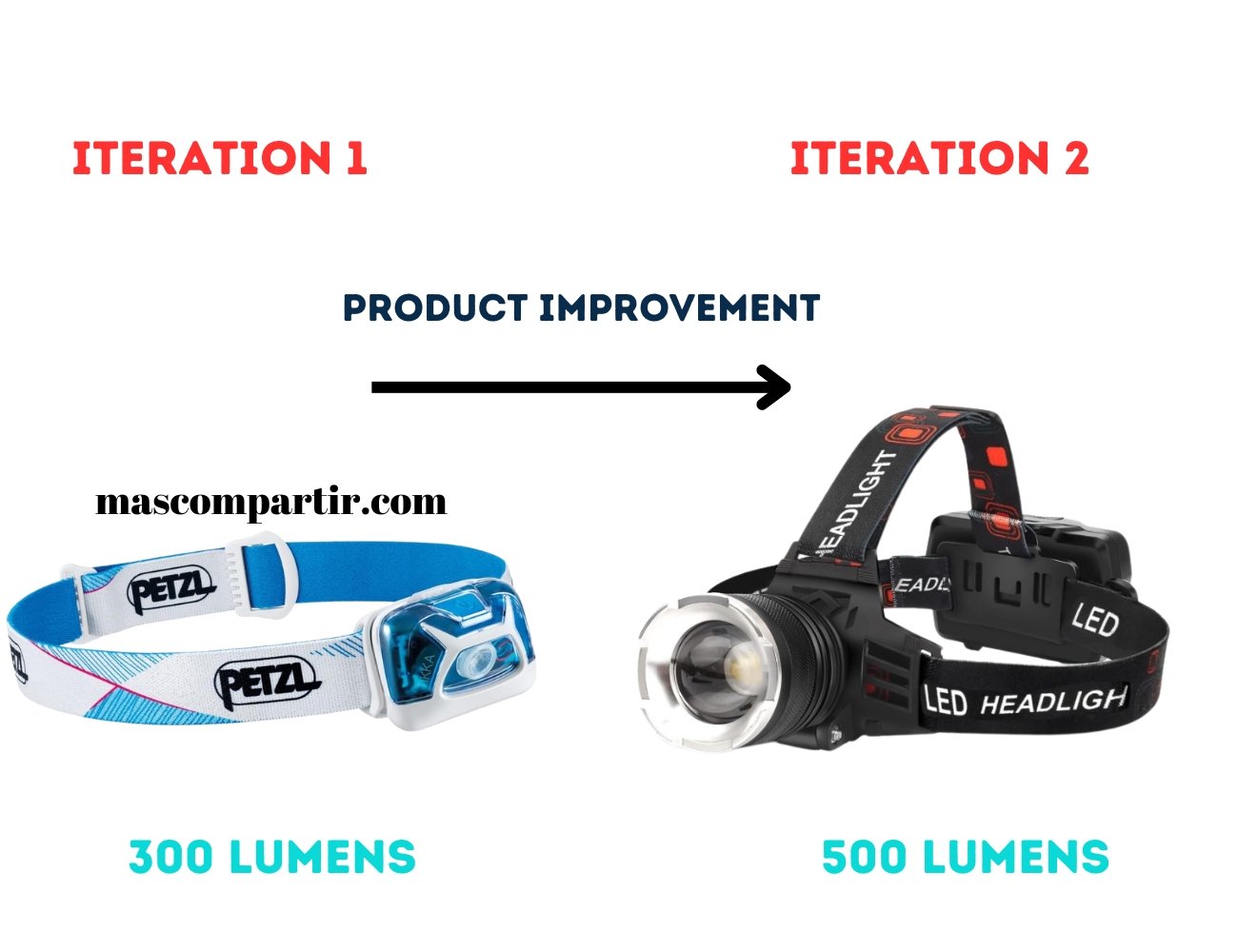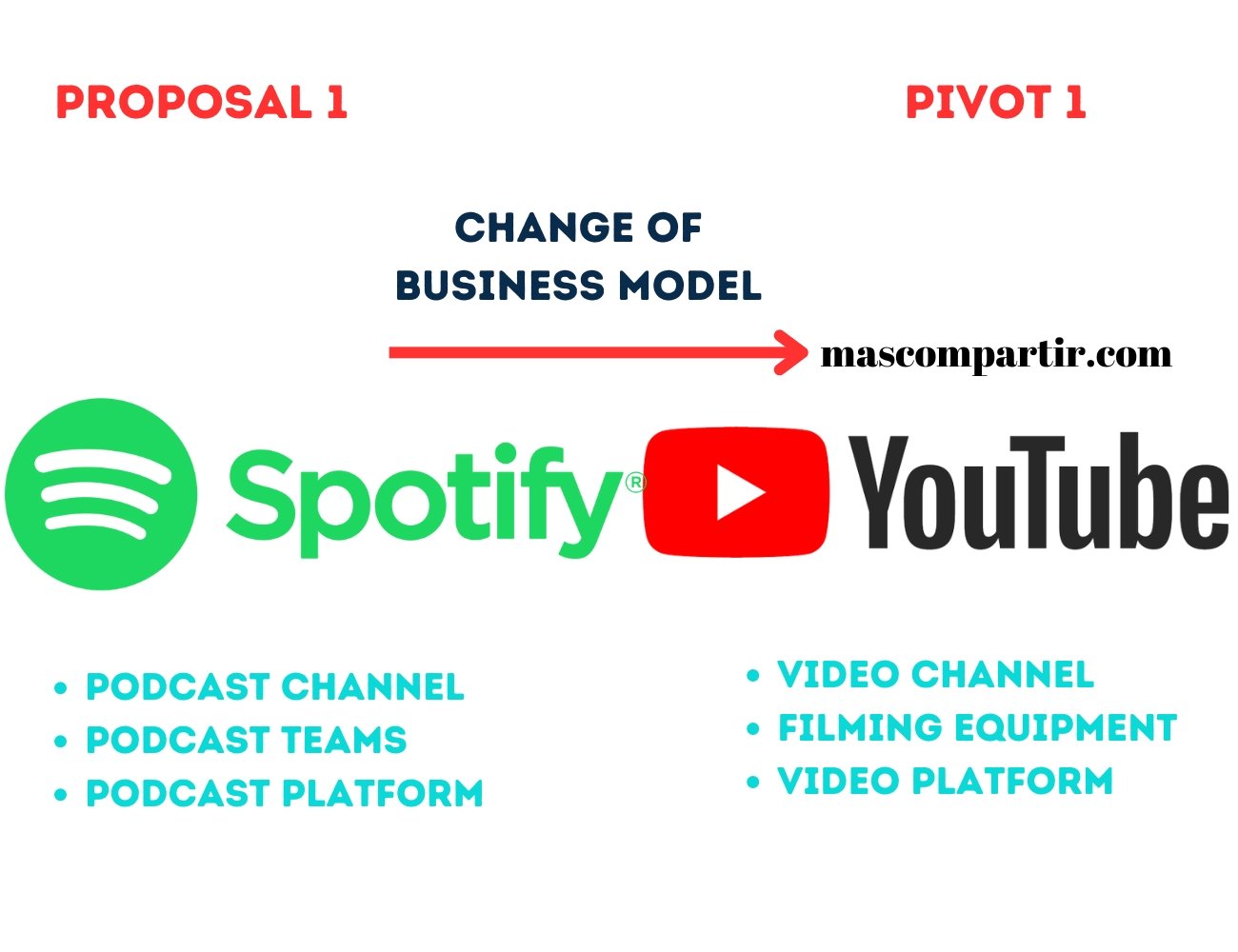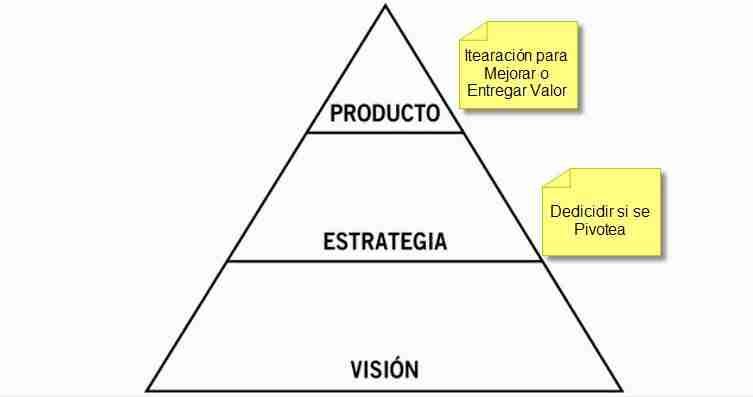Introduction
In the field of entrepreneurship and innovation, the words ‘iterating’ and ‘pivot’ are fundamental. Knowing the difference between these two terms can be the key to successfully navigating the uncertain sea of the startup world. This article breaks down these concepts, clarifies their roles, and provides practical examples.
The Lean Startup Triangle consists of the following elemen

A.- Vision – The Guiding Beacon
The vision of a startup is more than its fundamental purpose; it is the pillar that justifies its existence and its strategic guide. This vision fulfills an essential function: to serve as the beacon that lights the path, especially when faced with the need to iterate or pivot. At the crossroads between refining the existing strategy through iteration or changing direction through pivoting, it is the clear and solid vision that provides the necessary criterion for decision-making. Therefore, maintaining a well-articulated vision is vital for deciding when to iterate to improve or when to pivot towards new opportunities.
B.- Strategy: The Blueprint for Action
Strategy is more than just a map; it is the detailed recipe for realizing the vision of your startup. It is in this setting that critical decisions are made about whether to iterate or pivot. Minor adjustments along the way are categorized as iterations, and these are strategic refinements that bring you step by step closer to the larger goal. In contrast, the act of pivoting means a more radical overhaul of the current approach, a significant recalibration that aligns the company with new opportunities or challenges.
C.- Product – The Embodiment of Vision and Strategy
The product is not just the tangible outcome of a startup; it is the concrete manifestation of its vision and strategy. Originating from an innovative idea and guided by a carefully designed strategic plan, the startup team strives to develop a product or service that not only meets a need but also raises the quality of life of its customers. It is this product or service that allows the startup to iterate or pivot, adjusting its offering based on market feedback and emerging opportunities.

Startup team that has an idea that will improve the quality of life for customers, for which it will establish a strategy to be able to create a product or service.
1.- What is Iterating? Understanding Iteration: A Cycle of Continuous Improvement
The concept of iteration can occur in two contexts. The first is when you deliver value to your customer in order to learn quickly and complete the list of requirements for your product.
The second is when your venture faces challenges, which means that as a new proposal you will have to learn quickly to find your ideal customer and/or obtain valuable knowledge that will help you improve your value proposition.
The iteration or version of the product that you launch into the market for interaction with your potential customers will give you information to validate your hypotheses. Here, the goal is to determine whether it is worthwhile to continue, identifying signs that suggest that, with some improvements, the product or service will have a greater probability of fitting in. For this, we must answer the question: Is the customer’s acceptance of our value proposition close enough to justify moving forward with the plan? If the answer is positive, continue with the plan to release iterations or make adjustments to the product or service you are developing. This is from the perspective of the Lean Startup method.

Figure 1 – Product Improvement through Iteration
How to Iterate Effectively
Collect Data: Use analytical tools to gather data on how users interact with your product.
Analyze and Learn: Identify patterns and pain points.
Implement Changes: Make changes based on what you have learned.
Repeat: Go back to step 1.
2.- What is Pivoting?
Pivoting: A Strategic Change
The process of pivoting occurs when validated hypotheses are found to be false, requiring a rethinking of the entrepreneurial strategy. For this reason, it is crucial to design proper accounting at the start of a project, whether it’s in innovation, software development, a startup, or others. The accounting, expressed in numbers, must be recognized and accepted to avoid the risks of the «Entrepreneur’s Ego.»

Figure 2, Accounting must be above the ‘Entrepreneur’s Ego’ when making decisions
This is why pivoting helps you to change strategies and opt for another option that should have a higher probability because you have generated knowledge and increasingly understand your audience, not to mention that you have a bank of learned lessons for your new products.

Figure 3, Example of how a proposal decides to pivot after several unsuccessful iterations
Another interesting example is that of Microsoft. A few years ago, this giant stuck with the old model of selling software on disks with one-time payments, which were not affordable for everyone. This led to a preference for alternative tools like those from Google, and in many cases, people resorted to acquiring illegal software. With the arrival of Satya Nadella, there was a drastic change to the traditional model; everything was moved to the cloud, and the new proposal was that users paid for services, thereby lowering costs. Users could now purchase services for just one month or however long they needed.
Another example is Twitter, which started as a product called Odeo, a podcasting platform. However, when Apple launched iTunes, Odeo had to pivot and transformed into what we know as Twitter.
It is clear that behind this summary there is a significant transformation within the company to achieve the pivot of the value proposition. You can find more details about Microsoft’s Digital Transformation here: Radical Change of Microsoft.

Figure 4, Times to Iterate or Pivot
Common Reasons to Pivot
Market Fit Lack: Your product does not solve a significant problem for a sufficiently large market.
Market Climate Change: A change in market conditions, such as new regulations or technology, that makes your current value proposition obsolete.
Customer Acquisition Cost: You discover that the cost of acquiring a new customer is unsustainable.
3.-Example of a Company that Iterated and Pivoted
Case Atlantis
In 2017, the project was created for the implementation of a Manufacturing system integrated into the SAP system, and the SISCOP system was chosen. During the life cycle of the project, several iterations were attempted to improve the product (SISCOP) and deliver value to the users, but without success. After the closure of this project, the strategy was changed, and it was decided to switch to an Argentine system, the organization of teams was changed, experts in the sector were hired, users were trained, and this pivot was necessary and served to be successful in this new venture.
The company’s vision always remained, but as you can see, it was necessary to change the strategy and product to meet the organization’s objectives.
4.- Frequently Asked Questions (FAQ)
Is it better to iterate or pivot? The decision between iterating and pivoting depends on the specific context of your startup, the data collected, and customer feedback.
Can I do both? Yes, in fact, many successful startups have found their viable business model through a combination of iterations and pivots.
5.-Reading Recommendation: The Lean Startup Method
For those who want to delve deeper into the concepts of iterating and pivoting, and the Lean Startup methodology as a whole, we highly recommend reading the book «The Lean Startup» by Eric Ries. This book is essential reading for any entrepreneur or project leader interested in innovation and product development. To make it easier, you can click on this link to purchase the book.
5.-Reading Recommendation: The Lean Startup Method
If you find yourself exploring the world of digital entrepreneurship or simply looking to expand your knowledge about online platforms, I recommend reading our article ‘What is a blog?’ on MasCompartir. This article is crucial for understanding how starting a blog can transform your vision and open up new business opportunities. We delve into the benefits of sharing knowledge through the blogosphere, from establishing authority in your industry to generating leads and improving SEO. Visit the article to discover how a blog can be a valuable asset for any entrepreneur or business. Read the full article here.


![Los 7 Hábitos de Stephen Covey: El Método EXTRAORDINARIO para el Éxito [Videos Incluidos]](https://mascompartir.com/wp-content/uploads/2025/09/7-Habitos-de-la-Gente-Altamente-Efectiva-400x250.jpg)








0 comentarios